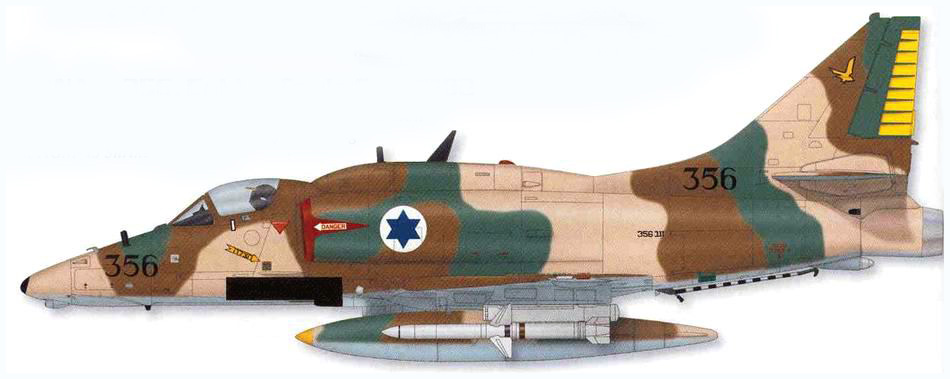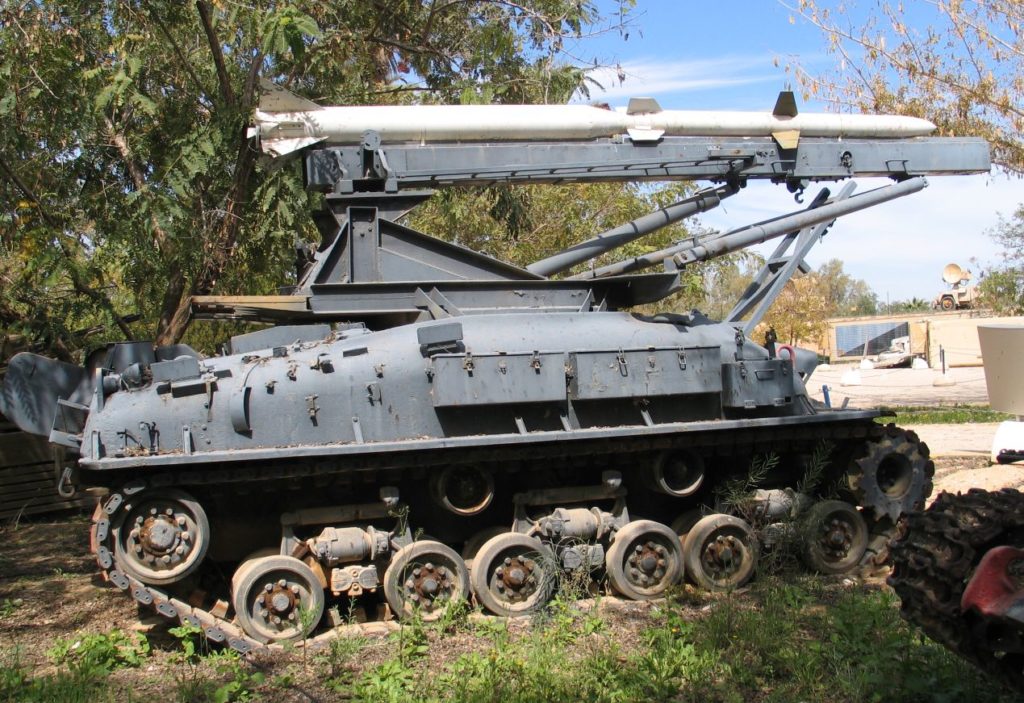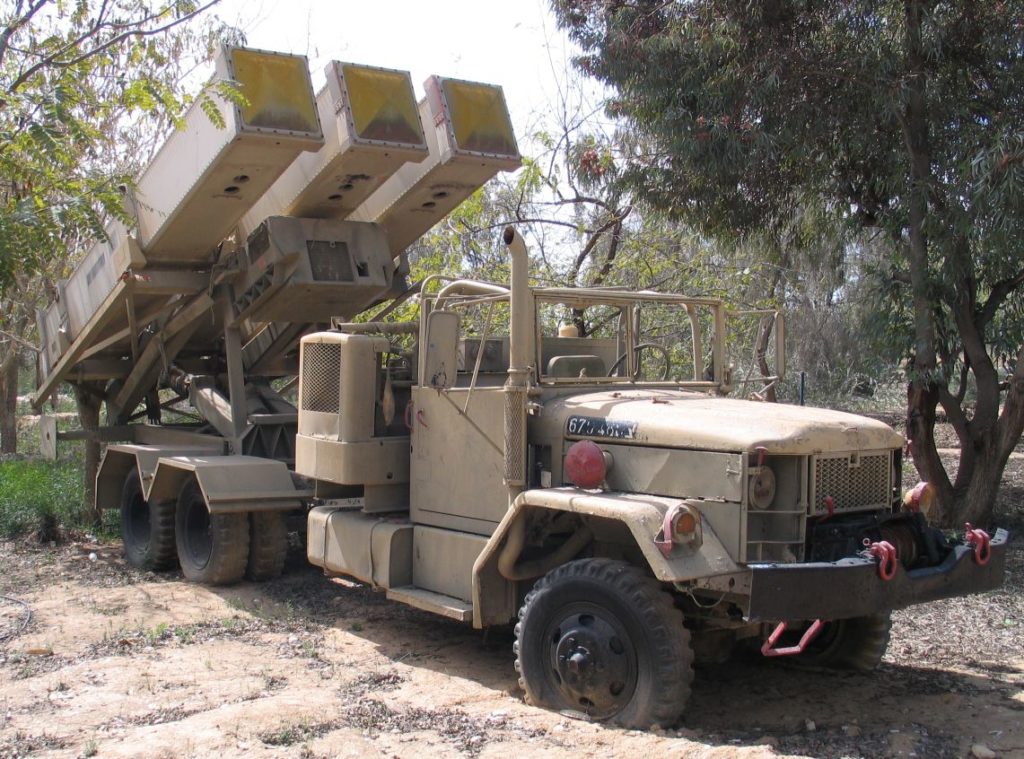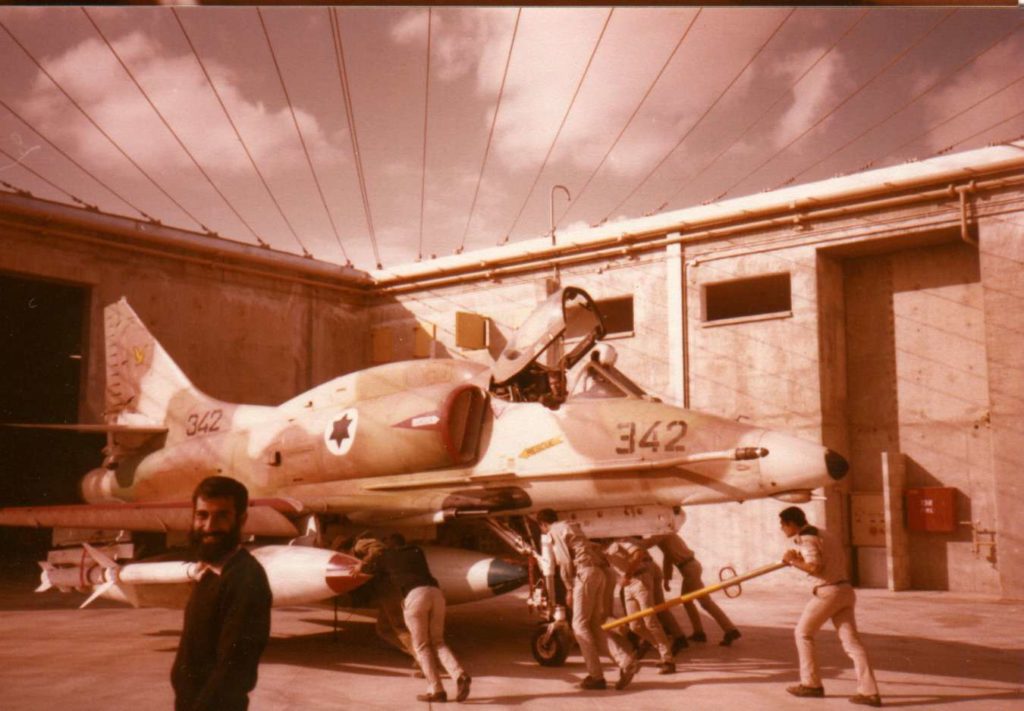Written by Oleg Granovsky; Originally appeared on oleggranovsky.livejournal.com; Translated by J.Hawk exclusively for SouthFront
Anti-Radiation Missiles (ARMs) are guided air-to-ground (in some cases ground-ground) missiles with a passive radar-homing guidance system. They are used to defeat enemy radars, including air defense, counter-battery, or surveillance, and they can be used to strike ships equipped with radars. This article covers such weapons used by the Israeli Air Force.
The War of Attrition was ended by a ceasefire between Israel and Egypt at midnight of August 7/8, 1970. The ceasefire which was to last 3 months actually survived until the Yom Kippur War of 1973. Right after the ceasefire entered into force, Egypt moved its SAMs to the Suez Canal zone, which was a major violation of its terms. Israel wanted to react immediately, but the US exerted diplomatic pressure to prevent it. Among other things, the US promised to increase IAF capabilities, including against SAMs, allowing Israel to purchase several previously banned weapons systems. Among them, Israel obtained AGM-45A Shrike ARMs, the first of which arrived in 1971. The IAF named them Egrof (according to Jane’s—Egrov Barzel for AGM-45A, and Egrof Nehoshet for AGM-45B).
On September 17, 1971, an Egyptian S-75 (SA-2 Guideline) downed an Israeli Boeing 377 Stratocruiser (Anak) electronic surveillance aircraft over Sinai, 22 km east of the channel. Seven crew members perished. In retaliation, on September 18, 1971 the IAF launched 12 Ergof missiles against Egyptian radars. However, since Egyptians turned off their radars, only one of the missiles struck the concrete base of a radar installation, inflicting some damage. The remaining 11 missiles exploded at distances between 1 and 5km from their targets.
Shrike missiles were carried by Skyhawk attack planes, initially only the A-4E model. When Israel signed the agreement for the purchase of the first Skyhawks in 1966, the current production model was the Shrike-capable A-4F. However, the US refused to supply Israel with several weapons and equipment for this model, and instead created the special A-4N model which didn’t have the Shrike capability. A-4N entered IAF service in December 1967, and on February 18, 1971 IAF received the first used A-4Es, which entered the 116th ha-Kanaf ha-Meofef (Flying Wing) and the 110th Abirey ha-Tzafon (Northern Knights) squadrons. Israel later received A-4N (after 1973, A-4M Skyhawk II for Israel) and used A-4F (during the last days of Yom Kippur War and shortly afterwards). During Yom Kippur War, only the 115th ha-Drakon ha-Meofef (Flying Dragon) Squadron had A-4N, the A-4F arrived too late. Phantoms could also use Shrikes, but the division of labor between squadrons meant only Skyhawks used Shrikes, including after the war.
But Israel apparently managed to obtain the more advanced AGM-54B model prior to the 1973 war. Both models were used during the war, with minimal success. For example, on early morning of October 7, 1973, IAF launched Operation Tagar to destroy Egyptian air defenses along the channel. The operation included 4 waves of attacks, with 8 Shrikes launched during the second wave (suppression of air defense artillery, 78 sorties). The third wave (attack on SAMs) was to employ ARMs on a large scale. But the worsening of situation on the Northern Front, the operation was cancelled after the second wave. On that same day, around noon, Operation Dugman-5 was launched to destroy Syria’s air defense system. The operation was a failure, as only one SA-3 battery was destroyed and one SA-2 battery was damaged, at the cost of 6 Phantoms (2 pilots killed, 9 captured). It’s known that the destroyed SA-3 battery was attacked by Shrike from an A-4E belonging to the 110th Squadron. No detailed statistics on Shrike use during Dugman-5 was published, but it is known that Israel obtained additional missiles of this type during Mivtza Manof (Operation Nickel Grass) emergency aerial supply of US weapons.
The well-known shortcomings of the Shrike were in evidence: the inability to “remember” the target’s location (once the radar was shut off, the missile lost guidance), narrow range of scanned frequencies (each Shrike model had over a dozen of modifications, each following different frequencies), weak 67kg warhead. Missile range was 16km (18-25 according to other sources) for the AGM-45A, and 40km-52km for AGM-45B.
In 1975, the US offered to sell Israel AGM-78 Standard ARM, which could fix target location, had a 97kg warhead, and range of up to 90km. However, in order to use it, one had to have Wild Weasel aircraft such as EF-4D or F-4G (the last built on the bases of F-4E and in production until 1978). Israel was not about to purchase such expensive and specialized aircraft, but did want the missiles. So instead the last F-4E batch (part of the Peace Echo V deal) received a Loral electronic surveillance system, and AGM-78 missiles were modified by General Dynamics in accordance with IAF specs.
The Standard model in production during 1973 and 19789 was the AGM-78D. Its guidance was modified to make it more autonomous in terms of frequency setting, in other words, do that which the Wild Weasel aircraft on-board systems did. It’s not known how this modification affected warhead size or range, but it was far more expensive than the base missile, as it cost several hundreds of thousands of dollars. But that was still cheaper than having a specialized Wild Weasel squadron. In Israel, these missiles were dubbed Ergof Sagol. After tests in the US, missiles arrived in Israel in 1976 and were ready for combat in 1977. The new F-4E fighters served in the 105th ha-Akrav (Scorpion) Squadron at the Hatzor airbase, which went on to become the last IAF Phantom base. The F-4Es served in the 105th Squadron between 1975 and 1987, and after it was shut down some of the aircraft were transferred to the 107th Abirey ha-Zanav ha-Katom (The Orange Stabilizer Knights), where they served until 1997. It was the 105th (and later the 107th) Squadron which used Standard ARM.
The 105th Squadron implemented a special Kurs hasaba course on the use of Egrof Sagol, including theoretical study of the missile, followed by various tactical scenarios. There was a simulator phase, followed by training flights with a training version of the missile.
Already in the early 1970s, before the Yom Kippur War, the IAF came up with the idea of ground-launched Shrike. But the work on it started only during the war, on direct orders of IAF commander Major General Beni Peled. The development was conducted by the MABAT plant belonging to IAI a few days before the war ended. The system was dubbed Potifar and consisted of a two-missile launcher on half-track chassis. However, the ground-launched Shrike had range of only 11km which meant firing from forward positions or even from behind enemy lines, which was suicida. The crew had nearly no time to stabilize launch vehicle and aim the missiles, the tactic was to occupy a firing position, launch, and leave. In any event, the war was over before ground-launched Shrike could be used.
Nearly at the same time, Israel began the development of a more powerful system named Kakhlilit or Kilshon (Trident). This work was conducted by the IAF jointly with IMI and TAAC. Shrike received a powerful boost stage separating after a few dozens of kilometers of flight. Range increased to 50-70km. One-rail launcher was installed on a Sherman tank chassis (photos show a cast M4A1 chassis, likely belonging to a former M-51). Initial tests began less than a week after the work started, and the whole development process was finished several weeks after the war ended. The Kakhlilit joint development team from IAF (Shabtai Duvdevani, the head of munitions department in the IAF Staff Technical Directorate) and IMI (Daniel Nerver) received the Israel Defense Award for 1974.
After Egrof Sagol entered service, a ground-launched variant was developed as well. This time the development was conducted by General Dynamics, the system was named Keres (Trigger), and a prototype was ready by the end of 1976. In 1977, 11 Israeli solders went to the US to study the weapon. Then it was tested at a range near Los Angeles, with 5 missiles expended over 5 weeks. Incidentally, Israelis shared the range with Iranians, for whom a similar but larger ship-borne Standard ARM was being developed, with a range of 130km. The AGM-78 was designed on the basis of a naval medium-range RIM-66 SM-1 SAM which had an ARM version RGM-66D already in US service. Thus the Iranians saw the Israeli system and vice versa.
Keres was tested in Israel before the 1982 war by the test-flight unit at an IAF range. Flights were followed by 14 cameras recording telemetry. The tests showed the system was fully functional: the missile exited the launch container, its fins opened, target was acquired and hit. The system was a huge step forward by comparison with Kahlilit. Apart from using far superior AGM-78 rather than AGM-45, Keres had longer range, mobility (truck rather than tank), and a crew of only 4. A Keres battery had several launch vehicles and a command vehicle receiving reconnaissance data and issuing launch commands, including frequencies of radars to be struck.
Kahlilit remained in service in parallel to Keres, but Potifar was quickly withdrawn. One can see photos of all three systems on a blog:
- Potifar
- Kilshon/Kahlilit
- Keres
According to SIPRI, the following deliveries of AGM-45 and AGM-78 took place (while the numbers of missiles are approximate, delivery dates are exact):
- 100 AGM-45A, delivered in 1970-71;
- 300 AGM-45A, delivered in 1973 (aid during 1973 war)
- 100 AGM-78, delivered in 1974-1976
The 1982 war was the heyday of IAF’s anti-radar weapons. On June 9, the operation Artzav-19 against Syrian SAMs in Lebanon featured the entire 105th Squadron—over 20 Phantoms carrying 2 Standard ARM each—as part of the first wave of the attack. Missiles were launched at ranges of several tens of kilometers, climbed to the altitude of 9km, and then plunged onto their targets. Syrian radars operated in an anti-Shrike mode (periodically turning off radars), which was ineffective against AGM-78. The 105th Squadron aircrews mentioned cases of being locked on by radars and even having SAMs launched against them, but that did not thwart the attack. In addition to the Egrof Sagol launches, several dozens of Kahlilit and Keres ground-based ARMs were launched as well. After that, SAMs were attacked by Shrike-carrying Skyhawks, and the now-blinded SAM batteries were destroyed by guided missiles and bombs from Phantoms of other squadrons. SAM positions were also hit by artillery and MRL fire, and toward the end Kfirs struck with cluster bombs. Artzav-19 was a success, Syrian air defenses were crushed with no Israeli losses.
In 1992, an IAF journal published an article about Keres, and in 1993 about Egrof Sagol, in 1994 about Kahlilit and Potifar. Also in 1994 the IAF museum displayed 2 Kahlilit launchers, a bit later 1 Keres launcher. It meant these systems were now withdrawn from service.
Since then the IAF ARM situation has not been clear. For example, several sources (Jane’s, Wikipedia) claim Israel has AGM-88 HARM (Kela or Slingshot, according to Jane’s). But not a single photo clearly confirming this claim has appeared in the last 20 years. There are also no indications of their existence in SIPRI data.
In 1995, IAF received the Delilah compact cruise missile developed by IMI. There are unconfirmed reports of an ARM variant. What is known is that Israel spread disinformation during Delilah’s development the missile is a decoy for disorienting enemy air defenses.
With ground-launched systems, there are reports IAF adopted the Harpy UAV, followed by Harpy-2 and Harpy-NG. According to Wikipedia, the truck-based launcher carries 18 UAVs, with a battery consisting of 3 launch vehicles. It may also be launched from ships. Delilah also has Delilah-SL (ship-launched) and –GL (ground-launched).
Attachment: the 153rd Squadron
IAF journal articles contain much sinformation about the unit armed with ground-based ARMs, but without providing its designation. According to Israeli-weapons.com, this is the 153rd Air Defense Battalion (Gdud 153), according to the Nahalal web site, it’s the 153rd Squadron (Tayeset 153).
Kahlilit and Keres remained in service for 20 years, before being replaced by Harpy UAV’s in the 1990s. Nahalal has not published detailed other than mentioning the squadron existed as of February 3, 2005.
A special unit was formed to combat SAMs using the Kahlilit and Potifar systems in late 1973 or early 1974. Its first commander was Lt. Col. Meri Livne who previously served as an air control squadron commander (Taeset Teufa) at an IAF base. Livne assembled the unit out of tank mechanics, electronics experts, SAM specialists, physicists and mathematicians.
After several months of active service, IAF decided to turn this into a regular unit. It received a number and a permanent base. It received a new commander, Maj. Ihiel Omri who earlier commanded a HAWK SAM battery. His two main tasks were turning the unit personnel into soldiers capable of working in the field and ensure proper maintenance for the Kahlilit (Potifar was no longer mentioned at this time, and apparently it was withdrawn in 1974). Omri borrowed servicing techniques from the air defense forces. Each system component (launch vehicle, missile, etc.) had a maintenance manual prepared (Sefer Ahzaka).
The unit’s core missions included preserving the secrecy surrounding the unit and its weapons. Even the base personnel did not know about the unit’s nature. There was a case of a tank transporter column arriving at the base to transport Kahlilits. Security did not want to let them in: “This is an IAF base, there are no tanks here”. Unit vehicles had no markings suggesting IAF affiliation. Even officer ranks were of the Ground Forces type rather than IAF. This created some difficulties, including in matters of supply. The unit concealed the fact of its active field status, therefore it was difficult to get equipment common to Ground Forces such as sleeping bags, winter jackets, etc. In some cases, equipment had to be purchased in civilian shops or improvised (sleeping bags sewn from two army blanks, etc.).
Wikepedia once wrote of existence of at least 2 Kahlilit batteries, with 5 launchers each. IAF journal did not specify the number of batteries, but does indicate 3 launchers in a battery. Launchers were moved on tank transporters, fully covered, while the missiles went by truck and were placed on launchers at the deployment area using mobile cranes (one per battery). Later trucks with built-in cranes were used and each battery had a transport/reload vehicle assigned which greatly reduced firing preparation time.
In the late 1974, the unit changed commander for the third time. This time it was Maj. Elizzer Yafe, a communications aircraft pilot who earlier occupied a staff post. He wrote the unit had high morale, everyone was a de-facto volunteer (or, rather, while people were assigned to it, nobody who didn’t want to serve there was kept on). Technicians were used to working on tanks, and serving in this unit was light duty by comparison. The unit warrant officer Badani was a former tankman who lost two fingers during the 1973 war. He later became the base warrant officer (RASAR ha-Basis).
Live fire exercises were held once every two months in order to explore the missile’s capabilities. While expensive, the permission for the exercises was continually issued. The unit held a large-scale exercise twice a year, during winter and summer.
A Kahlilit launch demanded high target aim precision, therefore the launch site was surveyed as if it were an artillery position, followed by a precise horizontal and vertical alignment of the launcher. IAF issued weather reports once every 12 hours, so the unit had its own meteorologists to conduct reconnaissance. Firing calculations were done by hand, using tables prepared by IMI and a Casio calculator, with corrections made depending on weather conditions in all the layers of the atmosphere that the missile would cross, therefore firing preparations took hours. Only later did the unit receive a computer and even then a civilian one which poorly functioned in hot weather with data entry using magnetic tape.
In 1977-79 the commander was Lt.Col. Yaakov Shmueli, an F-4 Phantom Radar Intercept Officer. His main task was introducing Keres, five batteries of which were purchased. Launchers were on a standard M809A1 5-ton army truck (3 missiles in hermetic launch containers). The systems were sent to Israel by ship, upon their arrival crews were rapidly trained in course of a month. All 5 batteries were in service by 1979.
It is not known who commanded the unit in 1979-82, but during the Lebanon War in 1982 the commander was Lt.Col Reuven Reshef, also a Phantom RIO. The unit participated in the war, batteries were deployed near central roads used by troop columns, which is how this information got into the media. The missile type was still held secret, so the newspapers wrote these were Ze’ev rockets, which actually existed but were short-range unguided rockets used by combat engineers.
June 6, 1982 was the only instance of Kahlilit combat use. As far as is known, it scored no hits, but Keres did, including against a Syrian radar on the Golan heights. While there is no concrete information, it is also understood Keres was used in Lebanon on more than one occasion, not only during Artzav-19.















